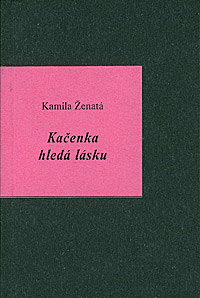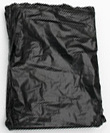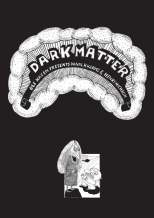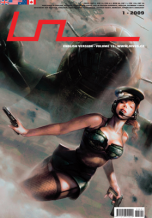| Umělec 2007/2 >> Interview with Luis Camnitzer | Просмотр всех номеров | ||||||||||||
|
|||||||||||||
Interview with Luis CamnitzerUmělec 2007/201.02.2007 Drew Martin | en cs de es |
|||||||||||||
|
Umelec, like other art magazines, discusses and reproduces art. In fact, the only thing that is original content is the writing for the magazine as well as the layout. The writing is diverse and timely and the images are of good quality but what affect does this mediation and interpretation have on us? How does verbalizing something visual, in different languages, and printing a second generation of an original image (especially sculpture) alter and prejudice our interpretation of art? To paraphrase Franz Kafka, "If you have to write love letters, something is wrong."
In a recent email-interview with Luis Camnitzer, a conceptual artist, curator and author, we discussed these issues of context. Umelec: Typically an interview with an artist is either about the person or that person‘s work. I would like to start off by asking you about this kind of discussion that we encounter in an interview. What is an art review, an essay on art or even a conversation about art? Is it a byproduct of the work, an extension of the work, a continuation of a dialogue an artist starts with us, the future and destiny of a piece or is it the ultimate goal/reward of the work? Camnitzer: It actually depends for whom and where it is written. The prevalent school of reviewing in the U.S. is based on description with the intent of facilitating consumption. But I would say that yes, it should be an extension of the art work and a form of feedback. I tend to write only when I want to figure something out that the work is leading me towards. In that sense I don‘t feel particularly proprietary about what I write. I feel that, in certain ways, the actual author is the artist. In this form of writing, the ideas that may come up never would have occurred to me on my own and I become more like a medium. Another part is the analysis of the problem(s) the artist may be trying to solve, and there a reviewer may come up with critiques about the rigor of the formulation, or the appropriateness of the solutions. In this case there is an act of evaluation that is only valid when it is not influenced by personal taste. Ultimately a text about art is only interesting if the art discussed becomes a generator of ideas that transcend the work and lead to more systemic discussions or perceptions. All of which puts a good text in the realm of good art. Then it may be rewarding, but never a reward. Umelec: Can you give me an example from your own collection of work where the anticipation of how the work would be discussed influenced how you went about creating it? Camnitzer: I would say that at some point that is always the case. I believe that art is a form of manipulation and communication, therefore I always keep in mind what I want to achieve and how to achieve it. This is particularly important when political issues are touched on. But even when I do purely speculative work, ultimately I have to package it (that is, deal with the aesthetics) in a way that engages the viewer (engagement is not necessarily connected with endearment). Umelec: Regarding the art review and your own work, would you rather have someone encounter your work without any prior knowledge of it and possibly not understand your intentions and the message of the piece, or would you rather someone see your work after he or she has read a review and is 'prepared' for it? Camnitzer: I don‘t have a preference. But I do have assumptions: I always assume that I am an anonymous creator that has to get the point across without any help. So, I assume an absence of reviews, as well as an ignorance of previous work, which makes self-quoting a meaningless activity. Umelec: I may be a bit redundant by dwelling on this idea of mediation but I think it is important in this context, on the pages of a magazine. This is a magazine. It is not a museum, gallery or a public space. Even if a photograph is placed here at the exact scale of the original it probably won‘t be the same quality and it will be on one side of a page, to be flipped through, perhaps missed. Is there something you have done which belongs right here? Camnitzer: Umelec: Why did you include these images in particular? Camnitzer: I like both pieces and they are not dependent on seeing the originals. Umelec: Every artist, writer and musician distills his or her experiences into the medium he or she knows best. Are there topics you try to explore where you find that visual/conceptual art is perhaps not the best approach: that maybe the subject is best handled through literature or music alone? Camnitzer: I think that is the case only because we are educated in a disciplinarian way. I mean this in the sense of fragmentation of knowledge, although the authoritarian interpretation is true as well. I don‘t consider that when I write, curate or facilitate learning or learn with others (I don‘t like the word "teaching") I am doing anything different. It is all about identifying my ignorance and trying to transcend it, about sharing my ignorance and helping others to transcend it. The medium should help in this and its choice is determined by this need, not by what I happen to have learned in school. Umelec: I recently read a statement made by Claes Oldenburg: "Becoming certain about a subject is a process over a period in time, beginning with hints from various sources and ending in a kind of monomania, in which the subject, by supreme coincidence, means everything - an inventory of nature in all its states, including opposites.“(1) If you can identify with this, is it a kind of blindness, a Holy Grail of art or Borges‘ Aleph under every staircase? Camnitzer:The statement is a little vague because I don‘t know what „subject“ is supposed to mean here. In any case, I do believe in the Aleph as a model. Like in the negative of a hologram, each fragment contains all the information of the whole, and ultimately it is an issue of literacy to be able to decode the whole from this fragment. That is why I believe that art is not just about information transmitted, but about the empowerment of decoding and generating that information. It is both research and sharing the researching. I think many artists try to create an Aleph. I just want to help discover them. Umelec: In 'The Shock of the New' Robert Hughes wrote: "It is hard to think of any work of art of which one can say, this saved the life of one Jew, one Vietnamese, one Cambodian. Specific books, perhaps; but as far as one can tell, no paintings or sculptures. The difference between us and the artists of the 1920s is that they thought such a work of art could be made. Perhaps it was a certain naiveté that made them think so. But it is certainly our loss that we cannot." (2) Hughes is sentimental. Is sentimentality the best we can do or is there a reason to be optimistic for some greater power in art? Camnitzer: I don't particularly like that statement, it seems a little naive in itself. Nobody ever believed that anyway. What was believed was that art could improve the world in more general terms. What got lost was the notion and the assumption of the responsibility that comes with it, that art is a shaper of culture. Art now is one more means of production of consumer objects and we are in a world that would force Einstein to think certain things only if he finds a publisher that can secure a minimum of sales of any book about those things. If we were dealing with the shaping of culture we would differentiate between different ethical impacts of our art, be concerned with art as a tool that helps to make sense of things and to keep our sanity, and see it as a process that leads to freedom and empowerment. If that would be the case, we would be saving many more lives than a single Jew, Vietnamese or Cambodian (just to respect Hughes' listing). Umelec: On the same page of 'The Shock of the New' Hughes also wrote: "Since 1937, there have been a few admirable works of art that contained political references - ...But the idea that an artist, by making painting or sculpture, could insert images into the stream of public speech and thus change political discourse has gone, probably for good, along with the nineteenth-century ideal of the artist as public man. Mass media took away the political speech of art." (3) He wrote that over twenty years ago. Is that statement still valid or have you and other artists grabbed the reins back? Camnitzer: I think that is true to some extent. The politically correct ads of Benetton during the 80’s and 90’s were a great example of the cooptation of the text. But that only means that we have to deal with the sub-text. Most of political art only informed about political content and used literary analogies. That was only viable in periods in which art was defined by literary content, and in certain ways was no more than a remnant of the nineteenth century. I think we are beyond that even if the media wouldn‘t have preempted the field. It never mattered much (nor should it) to the world if I am in favor or against a war. My function is not to disseminate my opinion. My function is to help people make their own decisions. As a manipulator, I of course will try to tweak the process so that the decision coincides with my beliefs. But I should do this without hubris or arrogance. It is not about grabbing the reins. As soon as you grab them, you have lost them. It is about subversion. Umelec: Also, for my own curiosity...What was/is your involvement with The Drawing Center in SoHo? I recently visited the current show, which you curated: Eleanore Mikus: From Shell to Skin. Camnitzer: I was the Viewing Program curator for over 6 years, in charge of "emerging" artists. Whenever I had a project that I felt strongly about and that was outside my territory, I would propose it and usually be able to do it. Therefore I was able to curate shows by Chago (the cartoonist of the Cuban guerrillas before the success of the Revolution, and a powerful artist afterwards), Peter Minshall (the Trinidadian Carnival choreographer), León Ferrari (the Argentinean forerunner of conceptualism), and now Eleanore Mikus. They are all artists that were un- or under recognized in the U.S., either due to provincialism or, as in Mikus‘ case, historical unfairness. In certain ways it was about making visible the invisible, which is an artistic proposition. I resigned from my position in The Drawing Center back in March, in solidarity with Catherine de Zegher when she departed. At the time we decided to leave, the projects the whole team was working on had come together in a way that would allow the institution to function until new personnel was hired. That was a good thing, since at the time of this writing only my position has been filled again. Meanwhile the other curators have left to other places and their positions also have to be filled. So, our planning of all the shows (except for one) up through September of 2007 turned out to be a very good idea. I had proposed the Mikus show three years ago and came back as a guest curator because Eleanore insisted that I be the curator. I will return for a Selections exhibit next September (Non-Declarative art) because it is a theoretical and idiosyncratic exhibition and I should take responsibility for it. Umelec: I have been loosely following The Drawing Center‘s situation at the World Trade Center site and there are many articles online that oversimplify the back and forth between the Center and ‚the public.‘ In a nutshell, there was concern that the Center would show work that might ‚denigrate America‘ and Ms. De Zegher responded that the Center would not be, 'censored.' How would you have responded in her place? Camnitzer: I obviously would have reacted exactly the same way Catherine de Zegher reacted, and that is why I handed in a very explanatory resignation the same day she announced her departure. I must say that in certain ways everything was somewhat predictable and the idea of moving to Ground Zero wasn't a particularly bright one to begin with. But then, fortunately, my position in The Drawing Center was a marginal one and I wasn't privy to the political subtleties of the Board. From outside it is clear that the invitation to be at Ground Zero only was viable if it implied an acceptance of critical expressions as being fundamental for cultural richness. Otherwise, accepting the invitation gives the inviting party the right to muffle and censor, or forced self-censorship. I don‘t know if this discussion ever took place. In any case, there were five artists invoked as objectionable. One was Mark Lombardi, who had committed suicide in 2000 and therefore, though he had exposed the connections between the Bush and Bin Laden families, cannot be blamed for offending sacred grounds. The other four were artists from my program who disagreed with racism and some governmental generalizations and I am proud of them and hope they sharpen their tools even more. In regard to taking advantage of the circumstances, I don‘t think you can do much in this case. Basically all the parties described themselves fairly accurately and left an array of self-portraits that are or will be considered by others. Ethics and the hope that they will prevail are really all one has left to resist fundamentalism. Luis Camnitzer is a conceptual artist who was born in Germany (Lubeck, 1937), immigrated to Uruguay in 1939 and has lived in the United States since 1964. He is a Professor Emeritus of Art at the State University of New York, College at Old Westbury. He was the curator of the Viewing Program, The Drawing Center, New York, 1999 - 2006 and is the pedagogical curator for the Bienal de Mercosur, Porto Alegre, 2007. Camnitzer was graduated in sculpture from Escuela de Bellas Artes, Universidad de la República, Uruguay, where he also studied architecture and then pursued sculpture and printmaking at the Academy of Munich. Camnitzer has received a number of fellowships including two Guggenheim fellowships and even more awards and honors. Camnitzer's work is part of the collections of the major museums throughout the Americas, Europe and the Middle East. He has also written many articles about the arts and is author of several books: New Art of Cuba, University of Texas Press, 1994/2004; Arte y Enseñanza: La ética del poder, Casa de América, Madrid, 2000, Didactics of Liberation: Conceptualist Art in Latin America, University of Texas Press, 2007. (1) Haskell, Barbara, Claes Oldenburg Object Into Monument, Pasadena Art Museum, 1971, p. 87] (2, 3) Hughes, Robert, The Shock of the New, Knopf, New York 1981, p. 111
01.02.2007
Рекомендуемые статьи
|
|||||||||||||
|
04.02.2020 10:17
Letošní 50. ročník Art Basel přilákal celkem 93 000 návštěvníků a sběratelů z 80 zemí světa. 290 prémiových galerií představilo umělecká díla od počátku 20. století až po současnost. Hlavní sektor přehlídky, tradičně v prvním patře výstavního prostoru, představil 232 předních galerií z celého světa nabízející umění nejvyšší kvality. Veletrh ukázal vzestupný trend prodeje prostřednictvím galerií jak soukromým sbírkám, tak i institucím. Kromě hlavního veletrhu stály za návštěvu i ty přidružené: Volta, Liste a Photo Basel, k tomu doprovodné programy a výstavy v místních institucích, které kvalitou daleko přesahují hranice města tj. Kunsthalle Basel, Kunstmuseum, Tinguely muzeum nebo Fondation Beyeler.
|

































 New book by I.M.Jirous in English at our online bookshop.
New book by I.M.Jirous in English at our online bookshop.
Комментарии
Статья не была прокомментированаДобавить новый комментарий